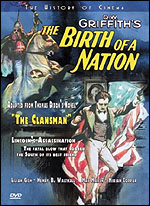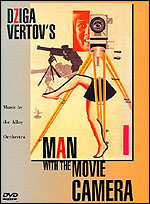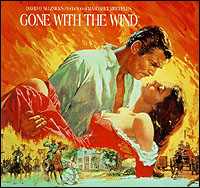Archives
Buffalo Film Seminars announces fall lineup
Controversial but landmark film "Birth of a Nation" to kick off 11th edition of popular movie series
By SUE WUETCHER
Reporter Editor

The controversial but landmark film "Birth of a Nation," will kick off the 11th edition of the Buffalo Film Seminars, the semester-long series of screenings and discussions sponsored by UB and the Market Arcade Film and Arts Center.
The series will take place at 7 p.m. on Tuesdays, beginning Aug. 30, in the Market Arcade Film and Arts Center, 639 Main St., in downtown Buffalo. It will be hosted by Diane Christian, SUNY Distinguished Teaching Professor in the Department of English, and Bruce Jackson, SUNY Distinguished Professor and Samuel P. Capen Professor of American Culture in the Department of American Studies and the Department of English.
Christian and Jackson will introduce each film. Following a short break at the end of each film, they will lead a discussion of the film.

The screenings are part of Contemporary Cinema (Eng 401), an undergraduate course being taught by the pair. The screenings also are open to the public at a cost of $8 for regular admission, $6 for students and $5.50 for those 62 and over. Season tickets are available any time at a 15 percent reduction for the cost of the remaining films.
Free parking is available in the M&T fenced lot opposite the theater's Washington Street entrance. The ticket clerk in the theater will reimburse patrons the $2 parking fee.

"Birth of a Nation," directed by D. W. Griffith, focuses on the effects of the Civil War on the lives of two families. The release of the film in 1915 prompted a censorship battle over its explicitly racist depiction of African Americans, and brought on riots in some major cities. Most film scholars agree, however, that it is a key film in American movie history. It contains many new cinematic innovations and refinements, technical effects and artistic advancements, and has had a significant impact on film history and the development of film as art.
Philip Carli will accompany the silent film on the electronic piano.

The remainder of the schedule, with descriptions culled from the IMDb online movie database, as well as www.filmsite.org and www.greatestfilms.org:
Sept. 6: "Man with the Movie Camera/Chelovek s kinoapparatom," 1929, directed by Dziga Vertov. This experimental, avante-garde documentary presents typical daily life in several Soviet cities and employs some of the first uses of split screen, montage editing, wild juxtapositions of images, double exposures and other special visual effects.
Sept. 13: "I Am a Fugitive from a Chain Gang," 1932, directed by Mervyn LeRoy. A gritty, uncompromising, critical and combative look at the barbaric treatment of criminals in a southern state's prison system following World War I. Considered to be the first of Warner Bros.' social conscience films during the early 1930s.
Sept. 20: "Bringing Up Baby," 1938, directed by Howard Hawks. Often considered the definitive "screwball comedy," this film features Katherine Hepburn and Cary Grant playing against type in a classic battle of the sexes: a mad-cap, scheming, accident-prone society heiress, and a bumbling, absent-minded, nerdy paleontologist from a natural history museum.
Sept. 27: "Gone with the Wind," 1939, directed by Victor Fleming. Perhaps the most beloved, enduring and popular film of all time, this historical epic of the Old South during wartime boasts an immortal cast in a timeless, classic tale of a love-hate romance. Stars Clark Gable as Rhett Butler and Vivien Leigh as Scarlett O'Hara.
Oct. 4: "Stray Dog/Nora Inu," 1949, directed by Akira Kurosawa. A young homicide detective has his pocket picked on a bus and loses his pistol. Frantic and ashamed, he tries to recover the weapon without success until taken under the wing of an older and wiser detective. Together they track the culprit. Considered by many to be Japanese director Kurosawa's first real masterpiece.
Oct. 11: "Umberto D," 1952, directed by Vittorio de Sica. Shot on location with a cast of nonprofessional actors, this neorealist masterpiece follows an elderly pensioner as he struggles to make ends meet during Italy's postwar economic boom. Alone except for his dog, he strives to maintain his dignity while trying to survive in a city where traditional human kindness seems to have lost out to the forces of modernization. His simple quest to fulfill the most fundamental human needs—food, shelter, companionship—is one of the most heartbreaking stories ever filmed and an essential classic of world cinema.
Oct. 18: "A Man Escaped/Un condamné à mort s'est échappé ou le vent souffle où il veut," 1956, directed by Robert Bresson. Based on a true story about bondage and rebirth from the memoirs of Andre Devigny, a French Catholic Resistance activist. The protagonist is imprisoned by the Nazis and sentenced to death by the Gestapo during the occupation. He plans an elaborate escape. On the day he is condemned to death, he gets a new cellmate—a 15-year-old French boy. Is he an informant?
Oct. 25: "Diary of a Chambermaid/Le journal d'une femme de chambre," 1964, directed by Luis Buñuel. Celestine, chambermaid from Paris, takes a job at a picturesque country estate. When the daughter of one of the staff is raped and murdered, Celestine does whatever is necessary to uncover the girl's killer. She quickly learns that her new employers, though apparent pillars of nouveau aristocracy, are as morally corrupt as the girl's murderer.
Nov. 1: "Andrei Rublev/Andrey Rublyov," 1966, directed by Andrei Tarkovsky. Suppressed by the Soviet Union and unseen until 1971, this film is a complex and demanding narrative about the responsibility of the artist to participate in history rather than documenting it from a safe distance. It charts the life of the great icon painter through a turbulent period of 15th century Russian history.
Nov. 8: "Bullitt," 1968, directed by Pete Yates. This film features one of the screen's all-time-best car-chase sequences—a 10-minute sequence filmed with hand-held cameras up and down the narrow, hilly streets of San Francisco as police lieutenant Frank Bullitt (Steve McQueen) chases after criminals in his '68 Ford Mustang GT.
Nov. 15: "Annie Hall," 1977, directed by Woody Allen. Allen's breakout film, this is the free-wheeling, stream-of-consciousness story of an inept, angst-ridden, pessimistic, Brooklyn-born and Jewish stand-up comedian and his unstable love affair with the equally insecure Annie Hall, a shy, flighty, Midwestern WASP and aspiring singer.
Nov. 22: "Marriage of Maria Braun/Die Ehe der Maria Braun," 1979, directed by Rainer Werner Fassbinder. In this film following the life of a young German woman married to a soldier in the waning days of WWII, Fassbinder has tried to show the gritty life after the war and the turmoil of the people trapped in its wake.
Nov. 29: "Brazil," 1985, directed by Terry Gilliam. A bureaucrat in a retro-future world tries to correct an administrative error and himself becomes an enemy of the state. "A combination science-fiction, despairing black comedy and fantasy."
Dec. 6: "The Leopard/Il Gattopardo," 1963, directed by Luchino Visconti. Set in Sicily in the 1800s, Prince Salina, a great landowner, has to watch his power and influence decline after "Il Risorgimento"—the unification of Italy. The upper classes try to ignore the nationalist movements, while the prince is uncertain of his own feelings.





For further information, go to http://buffalofilmseminars .com .
